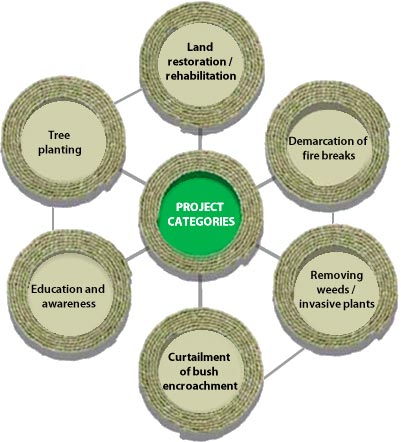Working for Land (WfL) project
Introduction and background
Working for Land is all about encouraging and supporting sustainable land use practices, raising awareness and promoting resource conservation ethics. It is a sustainable resource utilisation programme based on community partnerships and cooperation. Working for Land also seeks to address the issues of poverty through job creation by implementing various natural resource rehabilitation and conservation projects.
The United Nations Convention to Combat Desertification (UNCCD) is part of the three Rio Conventions which were founded in 1992. The UNCCD provides a framework for countries affected by desertification to address the problem of land degradation effectively on national and international levels. In September 1997, South Africa ratified the UNCCD. As a Party to the Convention, South Africa committed to the development and implementation of a long-term strategy to address issues relating to desertification rendering the department of Environmental Affairs as the focal point of the UNCCD in South Africa.
Desertification, along with climate change and the loss of biodiversity were identified as the greatest challenges to sustainable development during the 1992 Rio Earth Summit. UNCCD is the sole legally binding international agreement linking environment and development to sustainable land management. The Convention addresses the arid, semi-arid and dry sub-humid areas, known as the dry-lands, where some of the most vulnerable ecosystems and peoples can be found. Ecological restoration is widely used to reverse the environmental degradation caused by human activities.
The working for land focus area aims at empowering the greater community with rehabilitated areas of land by planting trees and make more land available for agricultural land grazing uses. The major challenges in working for land are:
- Storm water management to reduce soil erosion
- Unsustainable cutting of firewood
- Educational programmes to inform the communities on land management to improve the sustainability.
- Protection of grasslands.
This programme seeks to address degradation of land due to desertification, overgrazing, soil erosion, poor storm water management and unsustainable farming practices. Working for land intends to make more land productive for the communities to sustain their livelihoods.
Aims and objectives
Working for Land aims to restore and rehabilitate degraded land as well as the composition structure of environment leading to better performing ecosystems. Improvements on ecosystems generally will lead to carbon sequestration, better water yields and quality. This will reduce environmental risks and improve the sustainability of livelihoods while increasing productive potential of land and promote economic empowerment in rural areas. Restoration of land will improve natural species diversity and catchment stability.
- To restore and rehabilitate degraded land
- To encourage Biodiversity Conservation
- Curtailing of bush encroachment
- Mitigate loss of top soil which will enhance ecological integrity of the ecosystem
- Encourage better land use practices
- Environmental education and awareness
Project categories
1. Land rehabilitation and restoration
Projects implemented in this focus area aim at promoting the transition to sustainable and integrated management of land resources. The challenges addressed here can be as result of geological transformation, effects of desertification, soil erosion caused by poor storm water management and adverse land uses such as overgrazing. The deliverables in this category include:
- Gabion construction
- Planting of vetiver grass
- Tree planting
- Storm water channels
- Education and awareness
2. Curtailment of bush encroachment
Bush encroachment is the suppression of palatable grasses, small plants and herbs by encroaching woody species (trees &shrubs) which are unpalatable to domestic livestock. This encroachment is prevalent in Savanna eco-regions where woodlands are converted into shrubs. The impacts of bush encroachment include the reduction of arable land & threatening of livestock production. This contributes to threatening the sustainability of pastoral systems, reduction of biodiversity and threatening of livelihoods. The deliverables in this category include:
- Small scale removal of invasive shrubs, weeds or grasses
- Treatment of infested areas with herbicide
- Demarcation of fire breaks on the perimeter
Training and implementation
Approval of non-accredited plan
The Implementer must submit a non-accredited training plan to the Department for approval within sixty (60) calendar days of the start date of Phase Two. Training may not commence before the non-accredited training plan has been approved by the Department.
Accredited training shall be implemented by an accredited training service provider appointed by the Department as the accredited training implementer. No work shall commence without accredited training, in particular functional training (e.g. herbicide application, chainsaw operation) being provided to the beneficiaries.
Beneficiaries employed on the project
The Implementer shall employ people in terms of the Ministerial Determination No. 3: Special Public Works Programme as contained in Government Gazette No. 23045 of 25 January 2002 as amended. People shall be sourced from deprived wards within Taung area and they shall be remunerated in terms of the community wages provision. The Implementer shall enter into an employment Agreement with each person employed. The Special Public Works Programme requirements of 60% women, 20% youth and 2% disability should strictly be adhered to. The rate per day paid by the Implementer to the beneficiaries should be within the band determined by the Special Public Works Programmes.
The people employed on the project should be unemployed prior to the establishment of the project and shall not be receiving any income. An exception will only be granted to disabled people receiving grants. Only one person per household shall be employed on the project. Each team will consist of twenty (20) people and the total number of beneficiaries shall be 100 (i.e. five teams X 20 beneficiaries).
Community involvement / engagement
The involvement of community people will be a key determining factor for the success of the project – the project could only benefit the community people if their ideas and/or contribution are valued and taken into consideration. Community experts are crucial in providing the necessary indigenous knowledge regarding the area.
The Implementer should strive to impart knowledge to the community people on the dangers of degradation and on how to conserve their ecosystem.
Partnerships
Working for Land will partner with LandCare programme and other conservation groups/institutions in the catchment area. These include municipalities, farmers and/or farmer’s forums, universities and schools etc. This partnership will assist in terms of harnessing different resources and expertise that are required for the success of the project.
Value adding products
The implementer must explore means and ways to make use of the biomass cleared during the control of bush encroachment and Invasive Alien Plants for energy generation (e.g. as firewood/charcoal), cattle kraal and manure if possible. The money generated from value adding products shall be recorded and saved as specified in clause 9 of the memorandum of agreement (MOA).
Implementation or project execution
The project will be executed by the implementation agent in accordance with what is stipulated in the project charter/memorandum of understanding and Working for Land/Landcare norms and standards. The project technical report will specifically stipulate how this work should be done.
Hand over and maintenance
The Implementer is responsible to do one initial clearing and two follow-ups after which the land shall be handed over to the land owner for maintenance.
The initiative of controlling and preventing natural resource degradation should be a consistent and sustainable one once it has been started. The involvement of Working for Land will be to curb the prevailing problem of land degradation. Once this has been done to the satisfactory of both land-owners and Working for Land, the land will be handed-over to the land-owners who will take the responsibility of maintaining it. The Working for Land will however assist with technical expertise and herbicide whenever required.
- Monitoring
The Technical Team of experts/University shall from time to time contact monitoring to evaluate the project implementation against the prescribed methodology. The Implementer shall be available during the site monitoring where the Technical Team of experts/University shall assess methods applied and recommend corrective actions where defaults are recorded. The Implementer shall be reprimanded to apply such corrective actions. A failure to comply with recommendation of the Technical Team of Experts/University will be resolved through clause 12 of the MOA.
Risks associated with the project and risks management plan
- Risk Identification
- Loss of biodiversity – plants are an important ecosystem for species such as birds, wild animals, etc and removing them might result in losing some of these species;
- Deforestation – increase soil erosion and flooding. Plants are essential because they help to trap the soil and retards water flows;
- Inappropriate herbicide usage
- Desertification
- Mitigating Risk
All the risks can be avoided by executing the project according to the plan. The plan/approach is to do both thinning and selective cutting of plants. Thinning involves the removal of smaller poorly formed trees. Some these plants would anyway die before they reach their maturity, because of the unavailability of sunlight – as they are obscured by other taller plants. In selective cutting, individual trees are marked and cut unlike the entire stand of plants being eradicated. WfW herbicide applicators are trained on how to apply herbicide and are certified. A selective herbicide will be used and this kills only the applied stem.
Legislative framework
The Constitution of South Africa provides within the Bill of Rights that:
The constitution of the Republic of South Africa under chapter 2 of the Bill of Rights stipulates that: “everyone has the constitutional right to have an environment that is not harmful to his or her health and to have the environment protected for the benefit of present and future generations through reasonable legislative and other measures that — … (a) prevent …ecological degradation;(b)promote conservation; and(c) secure ecologically sustainable development and use of natural resources while promoting justifiable economic and social development, “The following are some of the legislations that are applicable:
- National Environmental Management Biodiversity Act (Act 10 of 2004)
- National Environmental Management Act (Act 107 of 1998)
- The Constitution of the Republic of South Africa Act (Act 108 of 1996)
- Environment Conservation Act (Act 73 of 1989)
- United Nations Convention to Combat Desertification (UNCCD)
Performance indicators
- Hectares of land rehabilitated
- Volume of gabions constructed
- Number of trees planted
- Ha of land curtailed of bush encroachment
Related events




